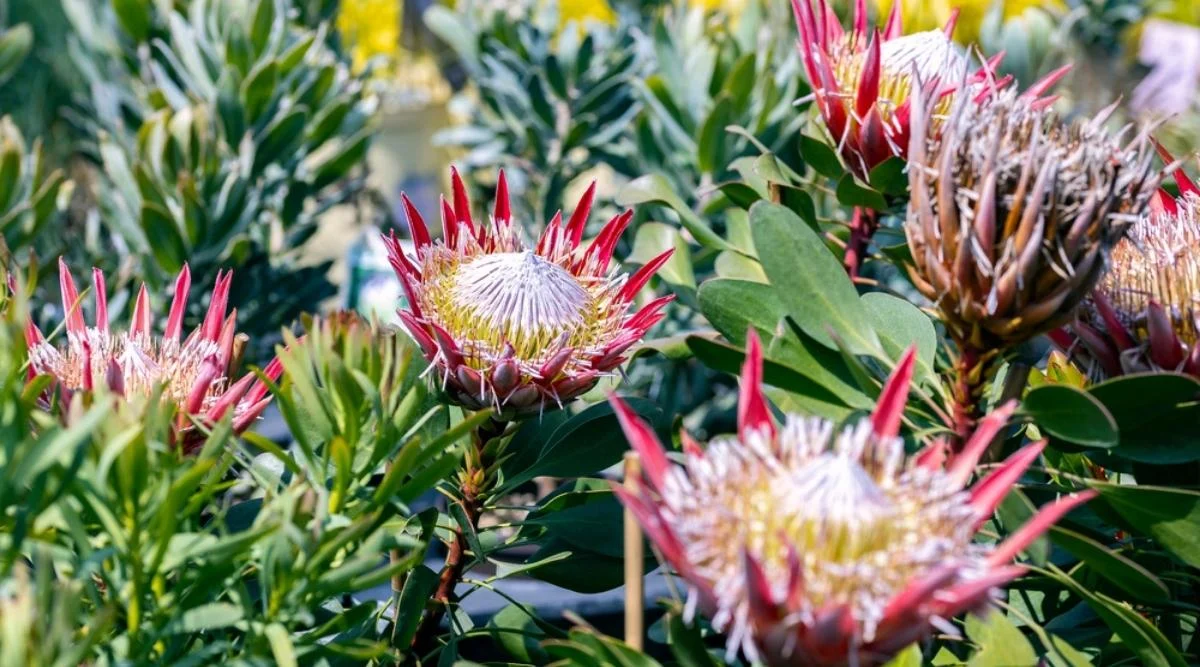justinpotts.com – The King Protea (Protea cynaroides) is one of the most iconic and dramatic flowers in the world, known for its striking, large blooms and vibrant colors. Native to South Africa, this stunning flower is not only a symbol of the country but also a favorite among gardeners and flower enthusiasts worldwide. With its bold appearance and unique form, the King Protea stands out in any garden, making it a perfect addition to both tropical and subtropical landscapes.
Appearance and Characteristics
The King Protea is renowned for its large, eye-catching flower heads, which can grow up to 12 inches in diameter. The flower is typically composed of dozens of petal-like structures called involucral bracts, which are often pink or red, surrounding a central cluster of creamy white or pale pink florets. The effect is both dramatic and beautiful, with the contrast of the bracts and the soft, creamy center creating a captivating display.
The plant itself has a bushy, upright growth habit, with leathery, dark green leaves that are long, narrow, and often have a silvery sheen. These leaves provide an elegant backdrop for the showy flowers and contribute to the plant’s overall striking appearance. The King Protea is a medium-sized shrub, typically growing to a height of 3 to 5 feet, with a similar spread. Its flowers bloom in late winter to spring, depending on the climate, creating a burst of color during the cooler months.
Growing Conditions
The King Protea is native to the fynbos region of South Africa, where it grows in nutrient-poor, acidic soils with excellent drainage. As a result, it is best suited to dry, well-draining conditions and should not be planted in areas with heavy clay or soggy soils. The King Protea thrives in full sun, which promotes healthy growth and abundant flowering. It is also highly resistant to drought once established, making it ideal for water-wise gardens or xeriscaping.
While it is a hardy plant, the King Protea does best in areas with mild winters and moderate summers. It is more tolerant of heat than cold and may struggle in regions with freezing temperatures. It is ideal for USDA hardiness zones 9-11, where winters are not too harsh. For areas with colder climates, growing the King Protea in containers and bringing it indoors during the winter months can be a good solution.
Care and Maintenance
The King Protea is relatively low-maintenance once established, but it does require specific conditions to thrive:
- Watering: King Protea plants are drought-tolerant once established, but they benefit from regular watering during dry spells. However, it is important not to overwater, as the plant is sensitive to root rot. Ensure the soil is well-drained and avoid keeping the roots soggy.
- Light: This plant requires full sun to flourish and should be planted in a location where it receives at least six hours of direct sunlight per day.
- Soil: King Proteas prefer acidic, sandy, or loamy soils with excellent drainage. Avoid heavy, clayey soils that retain too much moisture. Adding organic matter such as compost can improve soil structure, but be cautious with fertilizers, as the plant does not respond well to excessive nutrients.
- Fertilizing: Use a low-phosphorus fertilizer designed for proteas or Australian natives. Over-fertilizing can cause damage to the roots and reduce flowering. Apply fertilizer during the growing season, and avoid fertilizing during the dormant winter months.
- Pruning: Prune the plant after flowering to remove spent blooms and maintain its shape. Be gentle when pruning, as Proteas are sensitive to cutting too much woody growth. Light pruning will help encourage new growth and maintain the plant’s attractive form.
- Pests and Diseases: While King Proteas are generally pest-resistant, they can occasionally be affected by mealybugs, aphids, or root rot if conditions are too wet. Keep an eye on the plant for any signs of pests and take action if needed. Ensure good air circulation around the plant to help prevent fungal diseases.
Attracting Pollinators
The King Protea is a favorite among pollinators, particularly birds and insects. Its large, vibrant flowers are rich in nectar, attracting honeybees, bees, and birds such as sunbirds and hummingbirds. The plant’s ability to attract these pollinators makes it a valuable addition to any garden that aims to support local wildlife and biodiversity. It is also a great plant for pollinator-friendly gardens, where its colorful blooms can help sustain healthy ecosystems.
King Protea in the Landscape
With its bold, dramatic flowers, the King Protea is ideal for a variety of garden styles. It makes an excellent focal point in flower beds, where its unique shape and vibrant colors can steal the show. It also works well in coastal gardens, rockeries, or Mediterranean-style landscapes, where its hardy nature and low-water requirements make it a practical choice.
Additionally, the King Protea is an excellent choice for container gardening. By planting it in a well-drained pot, you can easily move it to different locations or bring it indoors during colder months. Its striking flowers also make it a popular choice for cut flower arrangements, where its bold beauty can be showcased indoors.
Conclusion
The King Protea is a stunning and resilient plant that can bring an exotic touch of beauty to any garden. With its bold, large flowers, drought-tolerance, and low-maintenance care, it is an excellent choice for gardeners looking to add a unique and colorful focal point to their landscape. Whether grown in the garden, in containers, or as part of a cut flower arrangement, the King Protea is sure to impress with its majestic beauty and captivating charm. Its ability to attract pollinators further enhances its value, making it a plant that is not only aesthetically pleasing but also ecologically beneficial.

